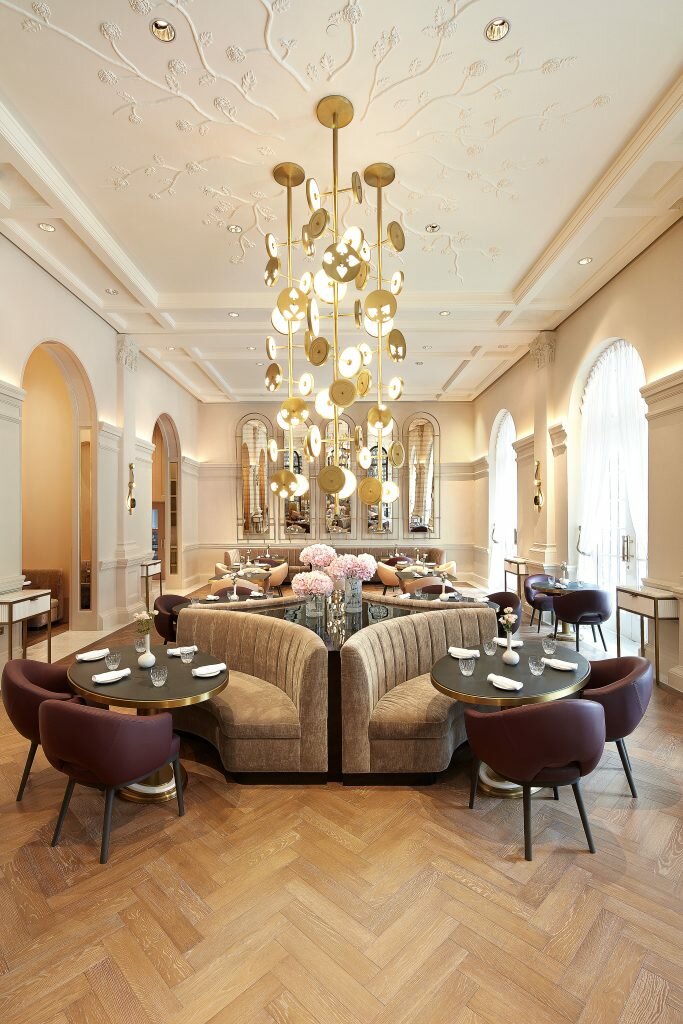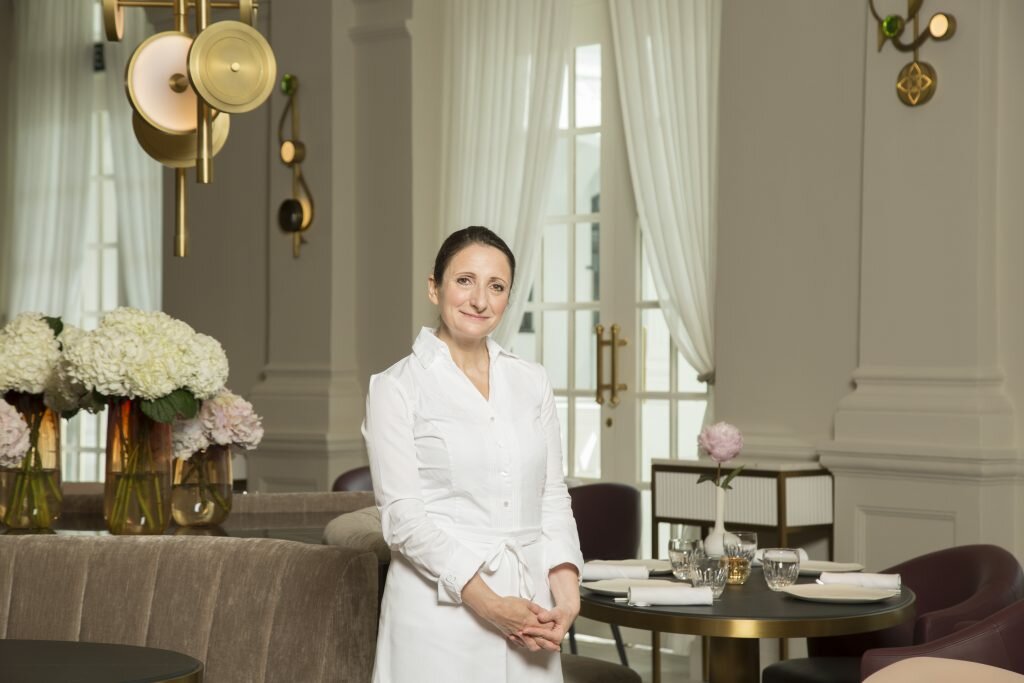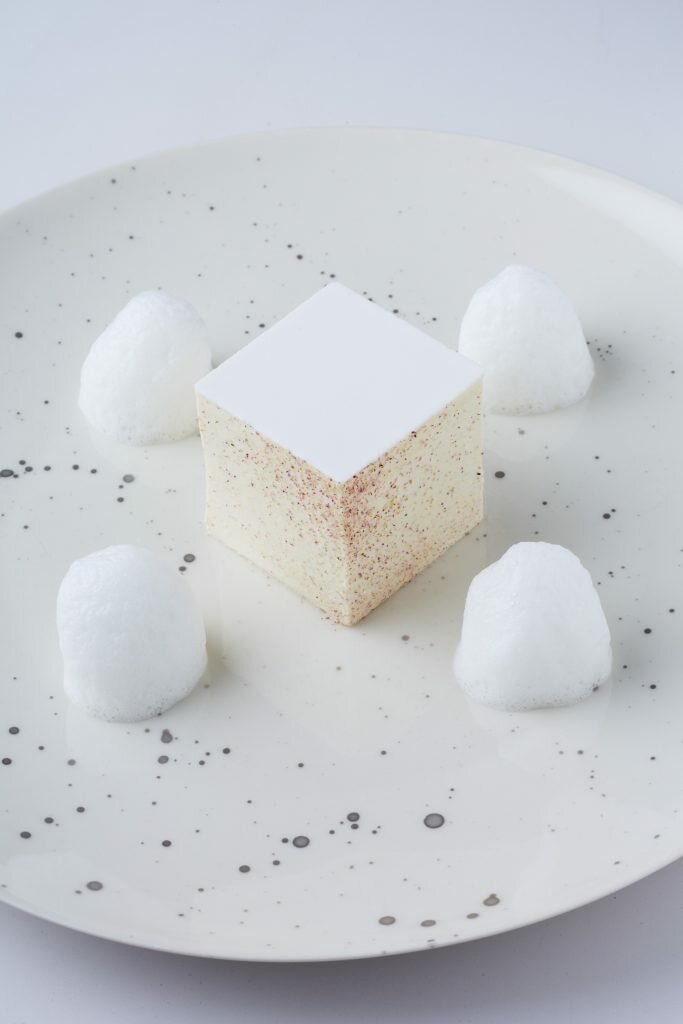It’s very clever cuisine. Each bite unveils new dimensions of flavour, from floral notes to bursts of zest and even an intriguing hint of bitterness, with each taste complementing and contrasting with another. Our minds were blown trying to figure out what makes it so amazing. Such is the beauty of the dishes by Anne-Sophie Pic, the chef-owner of new restaurant La Dame de Pic.
When the restaurant opened at Raffles Hotel Singapore this past July, she presented the latest incarnation of her signature berlingots—pyramidal pasta parcels wrapped around a fondue cheese centre. Only this time, they ooze with a buttery yet refined blend of Beaufort and Comté cheeses, which are balanced by the tang of green zebra tomatoes. This version also introduces a curious hint of bitterness from the herb of grace (locally known as chou cao), which contrasts against citrusy verbena.

Exacting and skillful, Pic is the rightful queen of spades, as suggested by the name La Dame de Pic. After all, she is only the fourth female chef to ever have been awarded three Michelin stars, and she was recognised as the Veuve Clicquot World’s Best Female Chef by the World’s 50 Best Restaurants. She counts a total of seven Michelin stars and nine enterprises on the list of her team’s accomplishments prior to this first Asian outpost—which we are sure will soon earn its own set of Michelin stars.
La Dame de Pic is stunning from start to finish. From the gorgeous dusty pink interior spiked by gold accents and the spade motifs to the exacting choreography of service and the refined execution of the cuisine, there was nothing not to be impressed with.

We sat down for a heart-to-heart with Pic, where we spoke about the loss of her father and mentor, her approach to flavour composition, and about being a feminist. Sit in on our conversation below.
Your family has owned Michelin-starred restaurants since the 1930s. Did you set out to achieve your own stars in order to fit into your father’s and grandfather’s shoes?
When I gained back the 3rd Michelin star for our family’s restaurant in Valence in 2007, it was for me the beginning, not the end.
I had a duty to honour my grandfather and father, and the third star finally released me. My grandfather was one of the first chefs in the world to get the third star. My father [who passed away in 1992, three months after Anne-Sophie joined the restaurant] got it in 1973, and my team and I won it back in 2007.
What is really important to me is the ability of each generation to be in tune with its time; the kitchen has to grow and evolve with it.
Stars and awards reward hard work, but they are never acquired forever. The third star, however, allowed me to gain confidence in myself, and feel legitimate. It gave me a freedom that can be witnessed today in my kitchen.
You only had three months to be mentored by your father when you joined the restaurant. How did you do it, not having been trained as a chef?
With audacity and creativity. I arrived in the kitchen 20 years ago with only my intuition and emotions to help me build my dishes following the sudden death of my father.
I learned while practising, and it gave me immense freedom. I dared to think of my own style of cooking, experiment with new flavours, and look for complex tastes which are not necessarily harmonious, but composed of contrasts and complements. For instance, I like to combine bitterness with acidity because it gives a perfect balance.
Would you call yourself a feminist?
I do not see myself in this cleavage of genders. Women can also be chefs because we live up to our commitment and we show sensitivity and humility!
There aren’t many women who are awarded though – that needs to be improved.
What do you think are the advantages of being a female chef?
A woman’s approach is different, perhaps less war-like, more empathic and collective. But in the end, what makes strength in a group is a balance between profiles with complementary skills. To me, sharing is a key element, just like what I am doing with my protégé of eight years, chef de cuisine Kevin Gatin who is helming the restaurant here.
Why Singapore, and what are your ambition and wishes for La Dame de Pic?
Singapore is a really dynamic and inspiring multi-cultural city. Opening here reminds me of La Dame de Pic London, where diverse kitchen horizons allow us to share our different cultural heritage.

How do you plan to differentiate La Dame de Pic from your other restaurants?
Every La Dame de Pic is different. The Singapore outpost is my most feminine restaurant to date, and we will adapt by using more regional ingredients. We are working on growing a herb garden on the hotel premises so my dishes can highlight the spirit of Asia—with a French touch.
Even for the bread and butter served at the beginning of the meal, I try to use local or regional products and taste. I chose, for example, to add genmaicha tea in one of the breads. And I always infuse a butter to refresh the palate, letting my guests discover a new and unexpected sensation. The challenge here is to play with the flavours, and create something new with my identity without denaturing the essence of the bread.
What’s your favourite dish from La Dame de Pic Singapore’s menu and why?
Berlingots! I was first inspired by sweets of the same name which I loved as a child. I created this pasta to recall the traditional Raviole de Romans [Ravioles du Dauphiné] from the region I was born in, using Comté cheese, milk curd, and parsley.
This is my signature dish. It is modern in shape and it allows me to create harmony in different flavours and textures. The sauce always comes with an aromatic complexity generally constructed upon bitterness, spiciness and floral notes to reveal all aromas of the ingredients. Sauces are always made a la minute to maintain their freshness. It can come with many different flavours depending on the season, the region and my inspiration. I have adapted the berlingots in my different restaurants using local produce to connect with each location and community.
What comes into play in your creation process?
The sense of smell plays a key role. It summons emotions and memories. But beyond that, I imagine myself to be a perfumer who creates his notes to be revealed over time. Top notes— which are the most volatile ones—are the first to be unveiled and constitute the first impression. Then comes the heart notes that prolong the freshness of the top notes and announce the warmth of the base notes, the latter being the one that lingers.
Flavours, spices and condiments play the role of these notes in my cuisine. The tasting must not be a linear experience. Each ingredient responds to another, sublimates the aromatic power, or prolongs the sensation in the mouth, playing with similarities or contrasts.

Your desserts and petit fours are as impressive. What is your philosophy with desserts?
The desert arrives at the end of the meal, when there is less hunger. Therefore, you need to be creative in many ways to generate curiosity. This makes the design a key pillar of the dessert. That said, I also play with aromas and surprise with new flavour associations. My other signature dish, White Mille-Feuille, features ginger flower light cream, as well as an emulsion where Litsea Cubeba (known as mountain pepper in Mandarin) is played against confit grapefruit.
The idea is to allow my guests to play once again, and to create memorable colours, textures and tastes.
